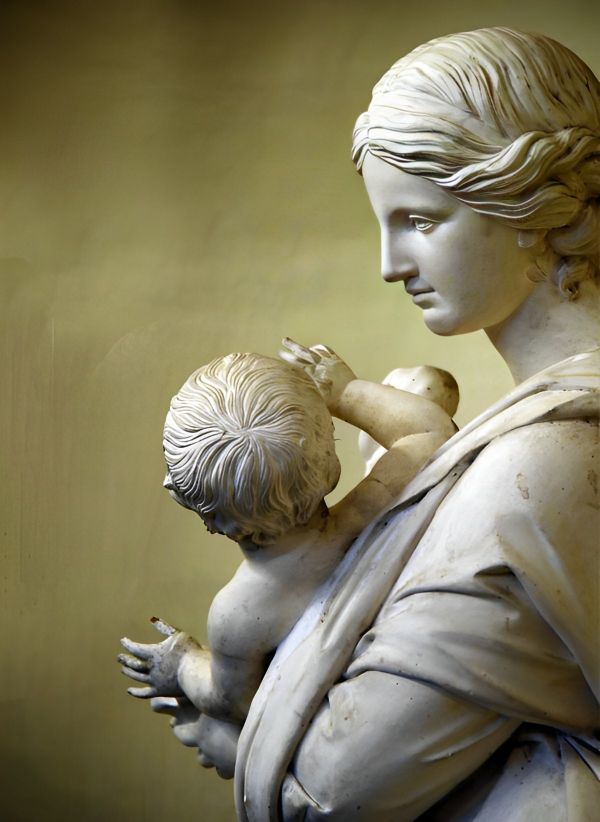February Fever
- Details
- Written by Lisa Iris
- Views: 1908

“The truth is never pure and rarely simple” said Oscar Wilde, and that applies to the origins of Valentine’s Day. Like a relationship status, “It’s complicated.”
This month’s mythic mish-mash can’t give a straightforward answer. Who was St. Valentine… all three of him? Where did the Heart originate, as it bears no resemblance to the physical organ? Was Lupercalia the original Valentine’s Day, or did something darker lurk in the Lupercal Cave? Should we thank a pagan-hating Pope for the most amorous day of the year? Let’s dive right in!

Groove Is In the Heart
As Emperor Heliogabalus (203-222 AD) asphyxiated his guests under a deluge of roses, we too are buried alive under hearts and flowers, culminating on February 14th. Is Hallmark entirely to blame, by continuing a profitable tradition established in the 1840’s? Year-round we’re inundated by hearts: as near-countless logos for tourism, companies, and foundations, or as gifts - from the heart-shaped “La Legende”Diamond (a mere $14.9 million) to novelty socks, or as a shower of emojis. Wherever an institution, object or sentiment portrays empathy or affection, there’s always a heart to draw you in.

Going back in time, the heart appears on hand painted playing cards, on heraldry and in medieval manuscript illuminations depicting courtly love. Was the heart an ideogram for erotic curves? Ultimately, the heart can be traced back to the 7th century BC, specifically to the city-state of Cyrene, Libya, N. Africa, along the Mediterranean coast. We immediately recognize the heart on Cyrenean silver coins. On the coins’ flipside are imperial profiles, deities or… a specific plant. This plant was Silphium, a species of giant fennel. Why was it depicted on currency, and considered “worth its weight in denarii,” as a hoard of Silphium was stored in the Treasury under the rule of Julius Caesar?

Maybe Baby!
Silphium, Cyrene’s cash crop and main export, was touted a gift from the Gods. It was both an aphrodisiac and a contraceptive. The classic heart shape depicted on Cyrene’s currency was Silphium’s seed pod. Our definition of a hot date - a delicious dinner, expertly prepared and shared, in anticipation of amor – could have its origin in the ancient world’s abundance of recipes that list Silphium as an ingredient, ostensibly as seasoning. Other uses for Silphium were as a component of perfume, and for the relief of headache, nausea and colds.
Was the resin from this plant an effective contraceptive? Centuries of Minoans, Egyptians, Greeks and Romans can’t be wrong! A low birth rate was an ongoing concern amongst Roman leaders, who blamed the hot baths for male infertility, but perhaps the ladies had Silphium up their sleeves. This plant was so popular, it was harvested into extinction between the 1st and 2nd century AD. Attempts to farm it outside of Cyrene had ended in failure. The last known reference to Silphium was a plant sent to Nero in 50 AD.

Feb. 15th - Return to Lupercalia
Our January article “Wolf Wisdom,” referred to the February 15th rites of Lupercalia, with a promise of more details. Remember Lupa the She-Wolf, Romulus and Remus? These festivities began in the Lupercal Cave at the base of Palatine Hill, where it was believed Lupa had suckled the twin brothers. In this cave, animal sacrifices took place. From there, two groups of twelve men from noble families - the Lupercali, being either naked or in loincloths, ran competitively down the Via Sacra, while flailing whips (flagellum) made of strips of goat skin. If you were a Domina Domus (or lady of the house), you’d throw yourself in front of these men, in order to be hit by their whips. If struck, you were now assured of a future pregnancy and a successful delivery. Revelry and copious wine flowed throughout Rome for two days.

Other events associated with February were the dedication of Temples to Juno Februalis, and to Faunus, a Roman variation of Pan, in 194 BC. Because February was associated with the goddess of marriage and childbirth, and to a god of livestock fertility (plus toga-less men running wild), it stands to reason that Lupercalia was a Pagan antecedent of Valentine’s Day. And yet, it wasn’t! There was more roiling under the surface.
You Give Me Fever
February was the last month of the 10-month Roman year, and Lupercalia was celebrated in the context of many other festivals, lasting for days. There was Parentalia, to honor the ancestors, Februa, a purification festival, and Feralia, dedicated to honouring the Manes - or spirits of the dead. This was observed by laying wreathes, sheaves of grain, and offerings of bread and wine at tombs. The merry making was balanced with civic duty through ritual, with Vestal Virgins in attendance - all for the purpose of Rome’s continued health and prosperity. There was also a Fornacalia Fest. (Get your mind out of the gutter! This event celebrated the Goddess of the Oven, Fornax. She was hot, and Romans needed bread for circuses. Terminalia signaled the last of the ceremonies, closing the year.

Februa means “fever” – a symptom seen as beneficial, as the body fights against an illness. Fever’s fire also connoted the burning of contaminated items, such as old straw or bedding. In that context, Lupercalia was part of that purification, also found in the flagellum’s sting. February’s rituals, both public and private, came together as cathartic cleansing, to propitiate the gods and placate the dead. As this month of festivals emphasized fertility, it was an occasion to create a purified state from which beginnings could take hold, evolve and flourish in the next year.
A Sketchy Substitute
As you can well imagine, the Christian Church didn’t think much of these goings on.
Despite the rituals being banned in 391 AD, it was nearly impossible to shut down this expression of the Roman psyche. Wolf-centric rites, known as Lykaia, were near-primordial, having been imported to Latium by Arcadian Greeks around 5th century BC., before the founding of Rome. In fact, February in ancient Greece was Gamelion: a time to celebrate Pan, lust, love and marriage.
Lupercalia was finally banished in 496 AD by Pope Gelasias, and the Feast of St. Valentine was established the same year, to throw the restless mob a bone. The She-Wolf, Juno, and Faunus were replaced by Valentine, who was sketchy from the start! Unable to verify this saint, Pope Gelasias described him as “known only to God.”

Like a player with multiple dating profiles, Valentine was initially confused with three different people! Was he the Bishop of Terni, the proselytizing martyr in North Africa, or the Roman priest who married couples in secret? (Rather like Friar Laurence in “Romeo and Juliet.”) The tale of the Roman priest won out for the Saint’s story. For all his kindness, Valentine lost his head in 269 AD by order of Claudius II, because marriage for Roman soldiers had been outlawed, and he’d attempted to convert Claudius II to Christianity. From his cell, he wrote a farewell note to his jailer’s daughter, (whom he had cured of blindness), which he signed, “From your Valentine.”
Love makes the world go ‘round, because you can travel the globe by visiting St. Valentines’ relics - in Rome, Greece, Spain, France, England, Scotland, Ireland, Austria, Poland and the Czech Republic. Ultimately, a most beloved and popular saint.
About the Author:
Lisa Iris is an artist and proprietress of MYTHOS Art and Counselling 289 High St., Fort Erie, ON. Her artwork is represented exclusively by crystalwind.ca and is featured in The Crystal Wind Oracle by Antonio DeLiberato.
Lisa enjoys opening her home to kindred spirits for conversation and for making magic happen.
Get The Crystal Wind Oracle Here!
Venus and Mars Artwork © crystalwind.ca. This article/text is Copyright 2023 Lisa Iris.
The Venus/Mars Artwork by Lisa Iris artwork licensed exclusively to crystalwind.ca and Antonio DeLiberato, worldwide agents for Lisa Iris Artwork. All Rights Reserved.
© 2023 crystalwind.ca. All rights reserved. Unauthorized copy or posting on other websites is prohibited. We track all IP addresses with sniffer technology. Using a Proxy/VPN will not hide your IP address.
Liked this article? Dive deeper into personal growth and wellness! Check out CrystalWind.ca for spiritual wisdom or explore AromaWorx.ca for natural well-being tips. Spread the positivity—share this with friends on their happiness journey!
Let’s Chat! Drop Your Thoughts Below! ![]()
Latest Articles
Dive into the Mystical World of the Crystal Wind Oracle Deck!
Get All the Enchanting Details Now!
NEW Expanded Boxed Edition!
Now with 58 Cards for Richer Wisdom!

Imagine a world of inspiration and healing, free for all—made possible by YOU!
Donate Now—Ignite the Magic at CrystalWind.ca!

Epilepsy - Finding A Cure
Your donation can make a difference!
Help us find a cure – donate now!
Follow Us!
Featured This Month
Crystals for Virgo
As the warmth of summer begins to soften into the crispness of autumn, the Sun... Read more
Sweet Violet
Sweet Violet Faithfulness and modesty. “I will always be true to you.” Helps... Read more
Sun in Virgo
An Overview of Sun Sign Characteristics for Virgo Virgo is guided by Mercur... Read more
Watermelon Tourmaline
Synonym: Rainbow Tourmaline The watermelon tourmaline is a rare variety t... Read more
Mabon Magic: Ideas For Fall Decoration And R…
Welcome (almost!) to Fall! We’re turning the Great Wheel once again, toward ... Read more
Peridot: The Healer's Stone
Peridot has been used as a Power Stone for centuries. Peridot fosters emotio... Read more
The Vine: September 2nd - September 29th
The Autumnal Equinox ( Alban Elfed ) Celtic Symbol : The White Swan Read more
Virgo Mythology
The Virgo Myth In all of constellation mythology, few legends are as misund... Read more
Mabon in Modern Times: Fresh Takes on the Au…
The Mabon season begins somewhere around the 21st-22nd of September and cont... Read more













































